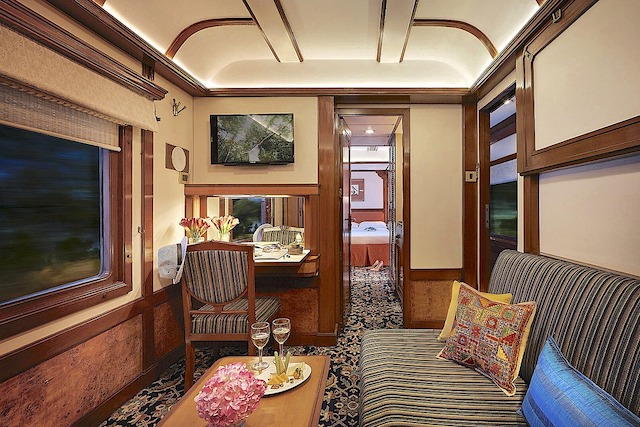10 Over-the-Top Ways the Wealthy Travel the World
Ever dreamed of traveling in ways that sound more like science fiction than real life? We dove deep into the weird and wonderful corners of the web to uncover ten of the most bizarre and fascinating modes of transportation that actually exist—or are about to hit the market. These aren’t your typical planes, trains, or cars. We’re talking about travel experiences that blur the line between reality and imagination. From affordable oddities to luxury rides straight out of a futuristic movie, we’ve ranked them by cost, so you can see just how far your budget—and your sense of adventure—can take you.
10. Hoverboards Are Real—But Not Quite Like the Movies

If you ever watched Back to the Future and dreamed of gliding through the air on a floating skateboard, you’re not alone. While we didn’t exactly get Marty McFly’s 2015, we did get something strangely close in our own timeline. In 2015, Lexus dropped jaws with the reveal of the SLIDE, a bamboo-and-carbon-fiber board that literally hovered off the ground. The 37-second teaser showed the board smoothly gliding above a magnetic surface—yes, really hovering.
Of course, there’s a catch (or a few). This was a concept prototype, and the whole trick works thanks to superconductors cooled by liquid nitrogen and a magnetic concrete track. In other words, you won’t be taking one of these down to your local skate park anytime soon—unless your park happens to be laced with magnets. The SLIDE requires a specially built surface embedded with magnetic rails to stay afloat, similar in principle to maglev trains.
Another contender, the Hendo Hoverboard, launched via Kickstarter in 2014, also relied on magnetic repulsion to get off the ground. But Lexus took it a step further with that vapor-spewing, futuristic aesthetic—and actual lift.
At around 11.5 kg, it’s not the lightest ride. And unless you fancy refilling liquid nitrogen every 10 minutes, you might just want to admire it from afar. Still, it’s the cheapest entry on this list of extreme transport dreams, and arguably the one that best blurs the line between science fiction and engineering reality.
9. The Tron Lightcycle: A Real – Life Leap from Virtual Reality
When it comes to iconic elements from the world of virtual reality, the Tron Lightcycle stands out like a beacon of futuristic coolness. For a long time, the idea of actually having a real – world version of this high – octane, neon – lit cycle seemed like a pipe dream. But as technology has advanced, what was once confined to the digital realm has started to make its way into our physical world – well, sort of.
Let’s get one thing straight right off the bat. You’re not going to be able to zip around and leave a trail of light walls like in the classic game of Snake, nor will you be able to hit breakneck speeds worthy of a high – stakes race in the Grid. However, don’t let that dampen your excitement too much. Just the sight of this contraption will surely turn heads and make you the envy of any Tron fan you happen to pass on the street.
The Tron Lightcycle has been brought to life by the innovative minds at Parker Brothers Concepts. It’s a remarkable creation that pays meticulous homage to its virtual counterpart. Crafted from carbon fiber and fiberglass, this replica is a true work of art. The use of these high – tech materials not only gives it a sleek and futuristic look but also ensures durability.
One of the standout features of the Lightcycle is its dual hubless wheels. These wheels not only add to the overall aesthetic appeal but also contribute to a smooth and unique riding experience. And let’s not forget about the lights. There are plenty of them, casting an otherworldly glow that captures the essence of the Tron universe.
Now, if you’re thinking about getting your hands on one of these bad boys, be prepared to shell out a significant amount of cash. The price tag ranges from 35,000to55,000. And while you won’t get a spandex jumpsuit to complete the look, you will receive a Tron helmet as part of the package. It’s like a little taste of the Grid in the real world.
Interestingly, the Tron Lightcycle has undergone an evolution, much like the franchise itself. There are two generations of this incredible machine. The first generation was a limited – edition run, with only five units ever made. Each of these was gas – powered and came in a distinct color, making each one a unique collector’s item.
The second generation, on the other hand, has embraced the future by going all – electric. This shift not only aligns with modern environmental concerns but also offers a quieter and potentially more efficient riding experience.
Whether you’re a die – hard Tron fan or just someone who appreciates cutting – edge design and technology, the Tron Lightcycle is a sight to behold. It’s a perfect example of how the boundaries between virtual and physical worlds can be blurred, bringing a touch of fantasy into our everyday lives.
8. Hoverbikes Are Here—And They Look Straight Out of Star Wars
Remember those flying speeder bikes zipping through forests in Return of the Jedi? Well, someone at Aerofex apparently did too—and they decided to build one. Enter the Aero-X hoverbike, a strange and slightly surreal blend of hovercraft and motorcycle, capable of skimming over just about any terrain without so much as a bump. No roads, no wheels—just you and two massive horizontal propellers pushing you across fields, deserts, or wherever you dare.
With a top speed of 45 mph and a hovering height of up to 20 feet, this beast isn’t built for racing, but it does feel like you’re riding something out of a sci-fi dream. The team behind it refers to it as a “crossover vehicle,” which is really just a cool way of saying it’s part drone, part bike, and all wild.
Who’s the target market for this $85,000 machine? Officially, ranchers, emergency responders, and border patrol units. Unofficially? Probably tech billionaires and thrill-seekers with deep pockets.
Technically impressive as it is, there are a few trade-offs. The hoverbike uses a rotary engine, a rare type of engine that’s lightweight and compact—perfect for avoiding the danger of seized propeller blades. But rotary engines also have a reputation. Just ask Mazda—they tried for years to perfect them, only to find they’re a nightmare when it comes to emissions and fuel efficiency.
7. Jetpacks: A Glimpse into the Future of Flight
Hey there, adventure enthusiasts! Let’s talk about something that’s straight out of a science – fiction movie: jetpacks. And no, we’re not just talking about the ones you see in old James Bond flicks. These incredible devices, along with their cousins, jet suits and jet belts, are no longer just figments of our imagination. They’re here, in the real world!
Sure, they’re still in the early stages of development, but the progress that’s been made is nothing short of astonishing. Just take a look at what JetPack Aviation achieved back in 2015. Their CEO soared around the Statue of Liberty using a jetpack. Can you imagine the thrill of flying like that? And this wasn’t just a leisurely stroll in the sky. This jetpack was capable of reaching heights of up to 10,000 feet at a speed of 55 knots.
But that’s not all. The company has since unveiled an even more impressive model, the JB – 10. This new kid on the block almost doubles the ceiling and speed of its predecessor. It’s like the jetpack has evolved into a whole new level of awesomeness.
And it’s not just JetPack Aviation making waves in this field. Numerous other companies are also jumping on the jetpack bandwagon. Some of them even offer full customization options. That means you can have a jetpack tailored to your exact specifications, like choosing the color, adding personalized decals, or even tweaking the performance features.
But wait, there’s more. Wearable jets aren’t just for thrill – seekers and adventurers. The military and emergency services are also testing them out. And the best part? You don’t need a pilot’s license to operate them. It’s like having a superpower at your fingertips.
However, there’s a catch. These jetpacks don’t come cheap. Prices are skyrocketing, reaching hundreds of thousands of dollars. For example, Mexico – based TAM sells a “rocket belt” for a quarter of a million dollars. And UK – based Gravity Industries has an Iron Man – style jet suit that’ll set you back almost half a million dollars (that’s £380,000).
Well, it’s mainly due to the cutting – edge technology involved. The development, research, and manufacturing processes all contribute to the high price tag. Plus, these jetpacks are still in the testing phase, and there’s a lot of room for improvement.
Speaking of improvement, there are some concerns that need to be addressed. Jetpacks are essentially “a jet engine strapped to your back” (don’t forget to check out this cool explanation of how jetpacks work). There’s a significant risk involved, which is why pilots are still required to wear tethers. This is to prevent any unfortunate accidents in case something goes wrong.
Another downside is the limited flight time. Most jetpacks can only stay in the air for just a few seconds or minutes. It’s like getting a taste of flying, but not being able to fully enjoy the experience.
Despite these challenges, the future of jetpacks looks promising. Who knows? In a few years, we might see them becoming more affordable, safer, and with longer flight times. So, keep your eyes peeled for the latest developments in this exciting field.
6. Flying Cars Are (Almost) Real, But Don’t Expect Jetsons-Level Speed
The dream of the flying car has been hovering over us for decades—usually more as a punchline than a product. Turns out, trying to mash together a vehicle that’s both road-legal and sky-ready is a massive engineering headache. It either flies poorly, drives terribly, or both—and usually costs more than buying a plane and a luxury car.
But that hasn’t stopped the visionaries at Alef Aeronautics. In 2023, they became the first to get a testing green light from the FAA for their electric flying car, the Model A. Unlike previous attempts, this one’s designed to feel and function like a car first—though admittedly, it drives like a car stuck in a school zone. The top speed? Just 25 mph on the road. Still, it can vertically take off, hover, and cruise for about 110 miles in the air, or 200 miles on the ground.
The Model A is all-electric and made with urban commuters in mind—assuming those commuters have around $300,000 to spend. Alef says deliveries could begin as early as 2025, with preorders already open. For $150, you can join the general waitlist. Want to cut the line? That’ll be $1,500.
This isn’t just futuristic hype—it’s a real flying machine with real FAA backing. But let’s be honest: for now, it’s probably more Silicon Valley flex than everyday transportation. Still, the idea of skipping traffic by literally flying over it? Unbelievable, yet closer than ever.
5. Amphibious Limo: A Lavish Ride for the Wealthy
When it comes to vehicles, cars that can run on both water and land might seem like a strange concept to the average person. After all, they often come with a significant compromise on speed. But for the ultra – rich, these amphibious vehicles solve a long – standing problem: how to get to and from their superyachts in style.
Typically, getting on and off a superyacht involves climbing into a dinghy or a speedboat. Then, when reaching the shore, you have to climb out, looking no different from the average person. It’s not exactly the most glamorous way to make an entrance. However, with an amphibious vehicle, the transition from sea to land can be seamless, allowing the wealthy to maintain their air of sophistication.
Unsurprisingly, most amphibious cars are designed with the wealthy elite in mind. Take Nouvoyage’s $2 million Limousine Tender 33, for example. This 33 – foot – long vehicle is a prime example of luxury at its finest. It’s furnished in a way that the rich seem to prefer, which some might describe as a bit “corporate – looking.” But hey, to them, it’s all about the opulence.
The Limousine Tender 33 has a seating capacity of 12, making it perfect for group outings. It’s equipped with state – of – the – art air – conditioning to keep everyone cool, even on the hottest of days. The retracting roof offers a touch of flexibility, allowing passengers to enjoy the open air when the weather is nice. And then there’s the gull – wing entry, which adds an element of drama and style. Oh, and let’s not forget the toilet, because when you’re traveling in style, you need all the comforts of home.
In terms of performance, this amphibious limo can travel up to 30 knots on water, which is quite fast for a vehicle of its kind. On land, it can reach speeds of up to 85 mph. Nouvoyage describes it as a great way to “make an entrance,” whether you’re arriving at a film premiere in Cannes or a dinner reservation in Les Beaux. But let’s be real here. This kind of vehicle could also potentially be used for more questionable purposes, like transporting people to an island with a dark secret, as the last line of the original text rather shockingly suggests.
4. Personal Blimps: The Floating Superyachts You’ve Never Heard Of
Imagine drifting silently over mountains, deserts, or oceans in your very own airborne lounge, cocktail in hand, while barely burning any fuel. It might sound like a scene from a sci-fi movie—or a billionaire’s fever dream—but personal blimps are starting to look more like the future of sustainable luxury travel than a retro novelty.
For two decades, Lockheed Martin—yes, the same defense contractor behind high-tech fighter jets—poured effort into developing a sleek, helium-powered airship. This thing could float for over 1,400 nautical miles, land almost anywhere (thanks to its hovercraft-style landing system), and didn’t even need ropes to moor—just a vacuum seal. But despite all that, nobody bought it. Not even the military. It quietly vanished into the vaults of forgotten engineering marvels.
But blimps are far from dead. British-based Hybrid Air Vehicles is filling that void with its luxurious Airlander 10. Priced at a cool $50 million, this isn’t just a means of travel—it’s a flying superyacht. With room onboard for lounges, spas, suites, and even sushi bars, it’s tailor-made for floating safaris, polar expeditions, or simply crossing continents in slow, spacious style.
While you won’t break any speed records—its cruising speed tops out around 80 mph—the trade-off is a drastically lower carbon footprint than a private jet. It’s a deliberate kind of travel: elegant, surreal, and truly one-of-a-kind.
If luxury blimps really do catch on, the skies of the future might be filled with floating palaces instead of roaring engines. And honestly? That sounds kind of wonderful.
3. Private Trains: A Luxurious and Exclusive Mode of Travel

When we think about train travel, most of us picture crowded public carriages or perhaps a cozy commuter train. But there’s a whole other world out there: private trains. Although they’re extremely rare in America, they do exist and offer a unique and extravagant way to hit the rails.
Let’s start with some examples of private railcars in the States. Former Amtrak CEO Wick Moorman owns a 1948 Sandy Creek observation car. He didn’t just keep it as a relic; he went all out and refurbished it. Now, this railcar has been transformed into a veritable home on wheels. It boasts bedrooms, a fully – functional kitchen, and a lounge area. In essence, it’s like an RV, but instead of rolling on highways, it glides along railroad tracks.
Another private railcar belongs to the president of the American Association of Private Railroad Car Owners. It’s an old Pullman sleeper car. Once a year, the members of this association come together and join their railcars for an all – private cross – country trip. It’s a chance to experience the golden age of train travel in a truly exclusive setting.
However, for the most part, private railcars aren’t self – sufficient. They’re usually hooked onto public trains that are heading in the desired direction. It might sound like a form of train – hopping, but it’s completely legal. That said, it’s not exactly the most exciting way to travel. It can be a bit boring, and it comes with a hefty price tag. You’ll have to pay $3.67 per mile for the privilege, plus an additional $1,800 per month for storage.
Since 2018, Amtrak has been less than enthusiastic about this niche mode of travel. They claim that private railcars cause “significant operational distraction” and can delay paying customers on scheduled services. Well, if you’re looking for a more independent solution, why not run your own train?
Enter the $350 million G Train. This is not just any train; it’s a custom – built behemoth that’s 1,312 feet long. Unlike some refurbished private railcars, the G Train was purpose – built from the ground up. It has a total of 14 cars, and some of these cars are equipped with fold – out wings. These wings create an outdoor dining area, allowing passengers to enjoy their meals while taking in the scenery.
But that’s not all. The G Train also has ample space on board for your fancy cars and motorbikes. So, you can bring your pride and joy along for the ride. And the best part? The shell of the train is made of technical glass. This innovative feature allows you to switch the glass from transparent to opaque at will. If you want to soak in the beautiful views outside, you can make the glass clear. But if you want to keep your activities private, you can simply make it opaque. Whether you’re looking for a luxurious getaway or a way to travel in style and privacy, the G Train offers it all.
2. Luxury Submarines: Billionaire Bunkers Beneath the Waves
When the ultra-rich crave true off-the-grid luxury, they don’t just buy a superyacht—they go underwater. In an era where spy satellites and paparazzi drones are peeking into every corner of the Earth, a surface vessel just doesn’t cut it anymore. If privacy is priceless, then a luxury submarine might be the most exclusive getaway money can buy.
Enter the Migaloo M7—a conceptual beast of a sub that looks like something a Bond villain might dream up during a champagne-fueled brainstorming session. Stretching an astonishing 928 feet, it’s nearly twice the length of the legendary Russian Typhoon-class submarine. Powered by diesel-electric engines, it can travel about 1,000 miles between refueling and descend as deep as 1,500 feet beneath the surface, making it a floating fortress of solitude.
And what’s inside? Everything. Literally. The M7 boasts helipads, indoor pools, hangars, cinematic viewing lounges, and a fleet of exotic toys—hot air balloons, minisubs, SUVs, and even a custom amphibious limousine. Think of it as a five-star resort, a private zoo, and a Bond movie set, all rolled into one steel-clad underwater leviathan.
The estimated cost? A jaw-dropping $2.3 billion, which, according to Migaloo’s CEO Christian Gumpold, would make it the “most expensive private object” ever constructed. But here’s the twist—it hasn’t been built yet. Why? Because they’re waiting on a buyer bold (and rich) enough to bankroll the first of its kind. Plus, navigating the uncharted waters of safety, crew logistics, and deep-sea mechanics is no small feat.
Still, if you’ve got the cash and crave the kind of privacy that only the ocean floor can offer, a luxury submarine may be your ultimate escape pod from the chaos above.
1. Nuclear – Powered Mega – Jet: A Concept That Sparks Both Wonder and Concern
Let’s dive into a truly mind – boggling concept: the nuclear – powered mega – jet, also known as “Flytanic.” Conceived as a flying cruise ship, this idea immediately conjures up some wild scenarios. It’s not hard to picture it falling into the hands of a megalomaniac, much like Doctor Robotnik’s Wing Fortress in Sonic. The very thought sends shivers down the spine, doesn’t it?
Now, let’s talk about its design. Inspired by the magical world of Studio Ghibli, this mega – jet is a colossal creation. It’s like a jumbo jet on steroids. Picture a vast central dome and a tail section that doubles as a viewing deck. It’s truly a sight to behold.
In terms of capacity, this thing is massive. It can accommodate 5,000 guests. But the use of the word “slaves” in the description adds a rather ominous tone. Hopefully, that’s just a mischievous choice of words and not a hint at some dystopian future.
On board, you’ll find all the amenities you’d expect on a cruise ship. There are swimming pools where you can take a refreshing dip, restaurants serving up delicious cuisine, theaters for an evening of entertainment, sports facilities to keep you active, and medical facilities for any emergencies. It’s like a self – contained floating city in the sky.
And here’s the kicker: it’s so large that regular aircraft could land on top of it without any trouble. Just imagine the sight of a small plane gently touching down on the roof of this aviation giant.
At the moment, the nuclear – powered mega – jet is just a concept. However, according to Hashem Al – Ghaili, who has delved deep into researching and animating Holmsten’s vision, the main hurdle is creating a nuclear reactor small enough to fit on the jet. But here’s the exciting part: he believes that this technological breakthrough could be within reach in the next two decades.
If this concept ever becomes a reality, it would revolutionize air travel. Imagine being able to take a long – haul flight that’s more like a luxurious cruise. You could wake up, enjoy a swim in the pool, have a gourmet meal, and then watch a movie, all while soaring through the skies.
But let’s not forget the potential risks associated with nuclear power. Safety measures would need to be top – notch to ensure that this flying marvel doesn’t become a nightmare.

























